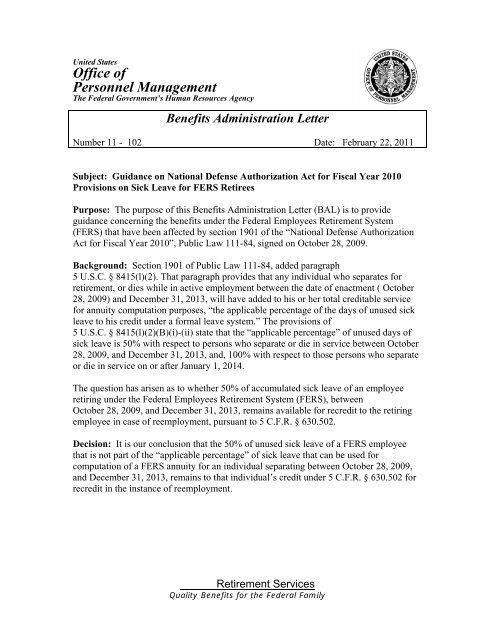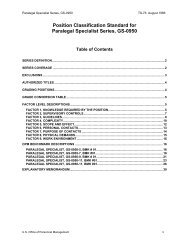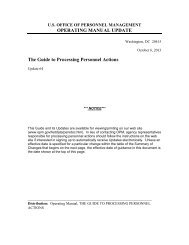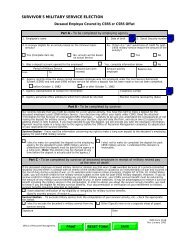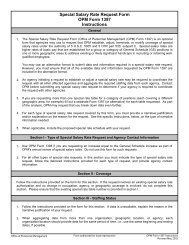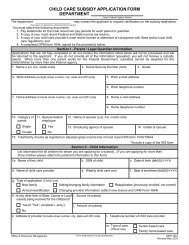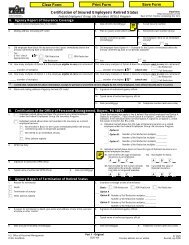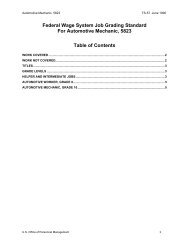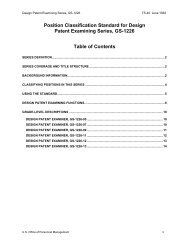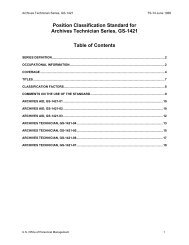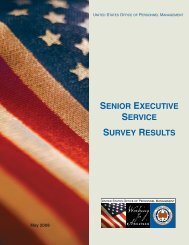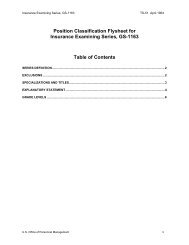Benefits Administration Letter - Office of Personnel Management
Benefits Administration Letter - Office of Personnel Management
Benefits Administration Letter - Office of Personnel Management
Create successful ePaper yourself
Turn your PDF publications into a flip-book with our unique Google optimized e-Paper software.
United States<br />
<strong>Office</strong> <strong>of</strong><br />
<strong>Personnel</strong> <strong>Management</strong><br />
The Federal Government’s Human Resources Agency<br />
<strong>Benefits</strong> <strong>Administration</strong> <strong>Letter</strong><br />
Number 11 - 102 Date: February 22, 2011<br />
Subject: Guidance on National Defense Authorization Act for Fiscal Year 2010<br />
Provisions on Sick Leave for FERS Retirees<br />
Purpose: The purpose <strong>of</strong> this <strong>Benefits</strong> <strong>Administration</strong> <strong>Letter</strong> (BAL) is to provide<br />
guidance concerning the benefits under the Federal Employees Retirement System<br />
(FERS) that have been affected by section 1901 <strong>of</strong> the “National Defense Authorization<br />
Act for Fiscal Year 2010”, Public Law 111-84, signed on October 28, 2009.<br />
Background: Section 1901 <strong>of</strong> Public Law 111-84, added paragraph<br />
5 U.S.C. § 8415(l)(2). That paragraph provides that any individual who separates for<br />
retirement, or dies while in active employment between the date <strong>of</strong> enactment ( October<br />
28, 2009) and December 31, 2013, will have added to his or her total creditable service<br />
for annuity computation purposes, “the applicable percentage <strong>of</strong> the days <strong>of</strong> unused sick<br />
leave to his credit under a formal leave system.” The provisions <strong>of</strong><br />
5 U.S.C. § 8415(l)(2)(B)(i)-(ii) state that the “applicable percentage” <strong>of</strong> unused days <strong>of</strong><br />
sick leave is 50% with respect to persons who separate or die in service between October<br />
28, 2009, and December 31, 2013, and, 100% with respect to those persons who separate<br />
or die in service on or after January 1, 2014.<br />
The question has arisen as to whether 50% <strong>of</strong> accumulated sick leave <strong>of</strong> an employee<br />
retiring under the Federal Employees Retirement System (FERS), between<br />
October 28, 2009, and December 31, 2013, remains available for recredit to the retiring<br />
employee in case <strong>of</strong> reemployment, pursuant to 5 C.F.R. § 630.502.<br />
Decision: It is our conclusion that the 50% <strong>of</strong> unused sick leave <strong>of</strong> a FERS employee<br />
that is not part <strong>of</strong> the “applicable percentage” <strong>of</strong> sick leave that can be used for<br />
computation <strong>of</strong> a FERS annuity for an individual separating between October 28, 2009,<br />
and December 31, 2013, remains to that individual’s credit under 5 C.F.R. § 630.502 for<br />
recredit in the instance <strong>of</strong> reemployment.<br />
Retirement Services<br />
Quality <strong>Benefits</strong> for the Federal Family
Guidance:<br />
For separations for retirement under FERS prior to October 28, 2009<br />
Only the amount <strong>of</strong> unused sick leave not used in the computation <strong>of</strong> a CSRS component<br />
will be available for recredit. If the separation occurred:<br />
� Before the amendment <strong>of</strong> the regulations repealing the three-year restriction, then<br />
the unused sick leave would be deemed to have expired as <strong>of</strong> the lapse <strong>of</strong> the<br />
three-year period; or,<br />
� On or after December 2, 1994, (the amendment <strong>of</strong> 5 C.F.R. § 630.502 repealing<br />
the three-year restriction), then the unused sick leave would remain available for<br />
recredit upon reemployment indefinitely.<br />
For separations for retirement under FERS occurring between October 28, 2009,<br />
and December 31, 2013<br />
50% <strong>of</strong> the total unused sick leave not used in the computation <strong>of</strong> a CSRS component <strong>of</strong><br />
an individual retiring under FERS shall be creditable for purposes <strong>of</strong> annuity<br />
computation. The remaining 50% <strong>of</strong> the total unused sick leave shall be treated as sick<br />
leave which can be recredited upon reemployment, and shall remain available for<br />
purposes <strong>of</strong> recredit on reemployment indefinitely.<br />
For separations for retirement under FERS occurring on and after January 1, 2014<br />
100% <strong>of</strong> the hours <strong>of</strong> unused sick leave not used in the computation <strong>of</strong> a CSRS<br />
component shall be used for purposes <strong>of</strong> computation <strong>of</strong> the FERS annuity. None <strong>of</strong> the<br />
hours <strong>of</strong> unused sick leave at the time <strong>of</strong> separation shall be available for recredit,<br />
pursuant to 5 C.F.R. §S 630.502 and 630.405, in the event <strong>of</strong> reemployment.<br />
For all periods <strong>of</strong> time<br />
The amount <strong>of</strong> sick leave that is available for credit in the computation <strong>of</strong> a FERS annuity<br />
is considered used in the annuity computation, (even if the credit does not result in an<br />
additional month <strong>of</strong> service in the annuity computation), and may not be recredited upon<br />
reemployment under 5 C.F.R. § 630.502.<br />
Agencies should identify any FERS employees who were initially retired on or after<br />
October 28, 2009, reemployed, and have subsequently retired again before the issuance<br />
<strong>of</strong> this BAL. This information should be provided to Michael Evans,<br />
Michael.Evans@opm.gov, or Phil Gardner, Philip.Gardner@opm.gov .<br />
William Zielinski<br />
Associate Director<br />
Retirement Services<br />
Retirement Services<br />
Quality <strong>Benefits</strong> for the Federal Family


